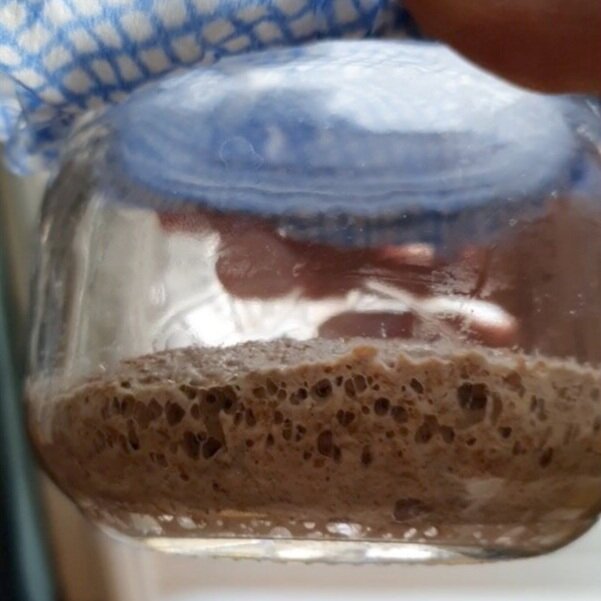MAKING YOUR SOURDOUGH STARTER
Here’s the recipe I use for my sourdough starter. It’s so simple and it works! I’ve also included a load of notes below to help answer some questions you might have, and I’ll be posting more bread content very soon…
Recipe
75g flour (I find the best results with organic wholemeal)
65g water
- Mix together in a bowl or on a work bench for a few minutes until you have a rough dough. Then place it in a bowl or jar covered with a cloth for about 3 days.
- A glass jar is a good container as you can see where fermentation bubbles have begun to form.
3 days after mixing the starter is lively with big bubbles. Time to start to build.
- Don’t leave it anywhere too warm. Just on the kitchen counter, out of direct sunlight should be fine. If it’s too warm you’ll be encouraging spoiling bacteria that will give off flavours and you won’t be able to use it. Room temp is fine.
- After 3 days there should be a dry crust on top that you can pull away to reveal some bubbly fermented dough below. It should have a pleasant acidic aroma.
- Now we’re going to build and strengthen it. Weigh what’s left after you’ve discarded the dry crust. It’ll probably be around 60g. We want to refresh this by doubling the weight. So add 30g water and 30g flour. Mix it well (I leave it in the jar and use a spoon), leave for two days.
- Hopefully you now have plenty of bubbles in the starter. But don’t expect it to rise just yet. Double the weight again. Add 60g flour and 60g water. Giving a total weight of 240g.
- Leave for two days and double again by adding 120g flour and 120g water. Giving you 480g.
- If your starter is noticeably swelling and rising after 24 hours, then it’s ready to make bread. However – it’s still very young and might not be strong enough just yet so I usually find that it’s best now to put it in the fridge for about 5 -7 days. I then remove it, discard half of the mix, and add back in 120g flour and 120g water to return it to 480g. Leave it out of the fridge overnight and it should be ready to make bread in the morning.
Please see notes below for further explanation.
____
1) Why no grapes/raisins etc
A lot of bakers will recommend adding all sorts of things to get the fermentation started: raisins, grapes, apples, honey, yogurt, rhubarb and more. But ultimately it’s pretty pointless.
When we make a starter we’re cultivating the wild yeasts and bacteria from the air around us and that already exist in the flour. Why attract the yeasts and bacteria that favour grapes? As soon as we remove those grapes (once the starter is up and running), the yeasts and bacteria they attracted will be overwhelmed by those that are better adapted to live on flour and water.
Adding the other stuff won’t do any harm, it just won’t serve any purpose. Flour and water is what bakers have used for 1000s of years, it works just fine.
2) Why keep the starter at 480g
The power of doubling is immense. If you double something 10 times over, it’s the same as multiplying it by more than 1000.
So we don’t want to just keep blindly doubling our starter without a method in mind. You’ll end up having to bin loads or you’ll get very unreliable results.
In my recipes, I use 230g of starter. So it works like this.
- Keep approximately 240g of starter in fridge when not in use.
- Day before baking double it to 480g and leave at room temp.
- Day of baking use 230g in recipe (and lose around 10g on spoon, edge of jar etc)
- Put remaining 240g back in fridge until required for next loaf (or refresh immediately if you’re baking the next day).
That’s it. No reason to ever end up with a bin full of unused starter.
3) The 7 days in the fridge…?
Honestly I don’t have a clear explanation for this. But I’ve tried it a few times and it works. My guess is that this prolonged period of slowed activity (yeast and bacteria continue to grow at slowed rates in the fridge) allows time for the well adapted strains to prosper, and the weaker strains to die out; so that when you return them to room temp and give them fresh food – bam! They’re back in action.
But I don’t know. A starter is a living thing and maybe it just needs some time to settle in.
4) Fix it or ditch it?
There are a couple of ways in which your starter can go wrong. And these usually happen in the first week or so. Because of this I often make two starters, a day apart, as you’ll rarely have two fail.
The first problem is mould in the first few days. If it’s just a tiny bit on top of the crust, I just pull the crust off and get on with building it. But if the the fermenting dough below smells mouldy, it’s time to start again.
Once the starter is up and running you shouldn’t have this problem.
The other issue is a starter in which the bacteria and yeast are out of sync. When things are working as they should, the two organisms have a symbiotic relationship and keep one and other in check. Sometimes this doesn’t happen though and the lactobacilli run wild and you end up with a starter that is powerfully acidic - like vinegar - and is very runny, as the bacteria have digested much of the protein in the flour. You’ll also find it is fermenting but not really rising. Again, this is a sign that the bacteria have run rampant, and the yeast have failed.
You can try dropping the weight down to 60g of starter and double it twice a day for a couple of days to see if you can nurse it back to health. But I tend to to just bin it and start again. It’s no big deal, it happens.
5) The older the better?
I think starters get better and stronger for the first few weeks then plateau indefinitely.
You might have heard romantic tales of 100 year old starters being passed down through generations and making the trip from Italy to America after the first world war…etc. It makes a good story, and I’m sure it happens. But it’s not really relevant to quality.
People tend to believe their starter has particular exceptional qualities over time for the simple reason that they have adapted to it. They know it’s rhythm and have learned to work with it. But if you’ve made it once you can make it again. It will just take a little time to settle in.
And if we move our starter from one place to another - it will quickly become inoculated with the new microbial life in that location, and on the new people surrounding it. This is most likely why the famous San Francisco sourdough isn’t repeatable elsewhere, despite numerous attempts.
In short - it makes sense to keep a good starter going if you can. But don’t worry too much. If you’ve made it once you can make it again. And ten years old is really no different to 10 weeks old.
So don’t do what a friend of mine did - and decline a 2 week holiday with friends for fear his starter wouldn’t survive his absence.
I love it more than most…but it is just bread.


